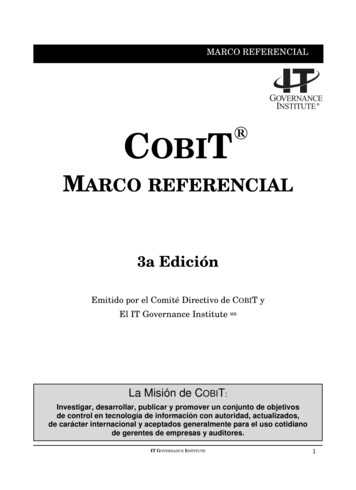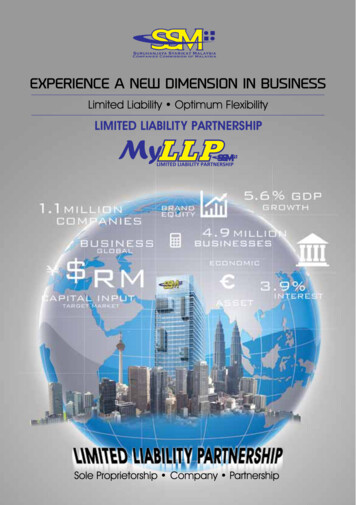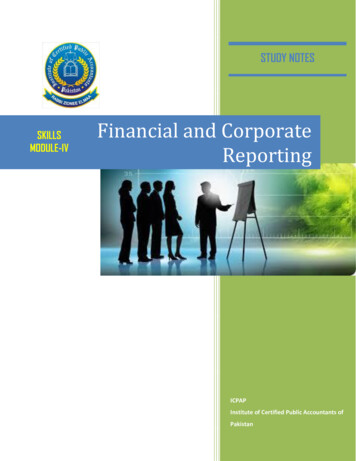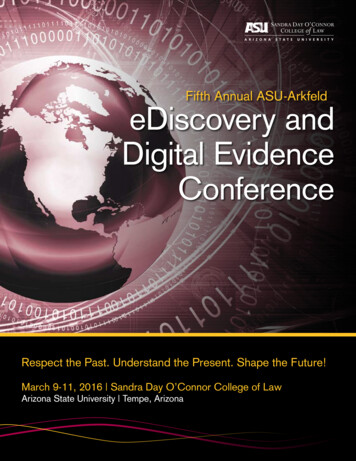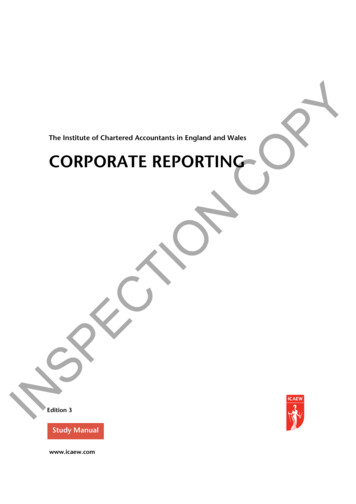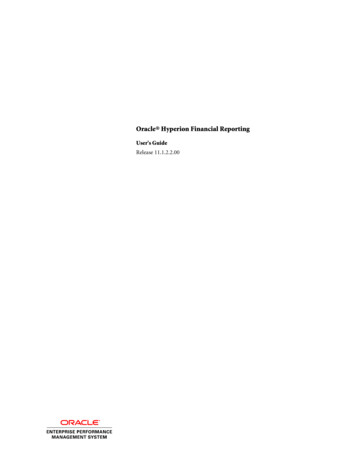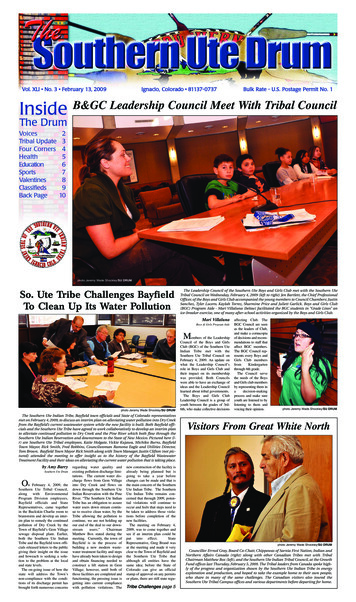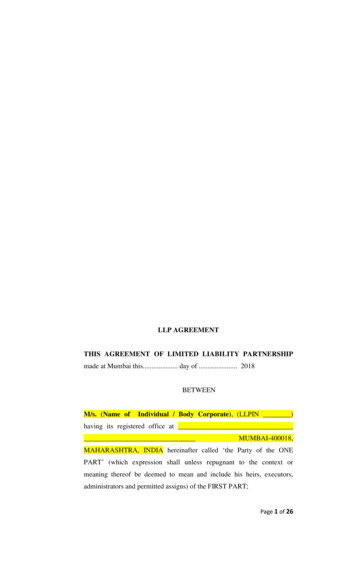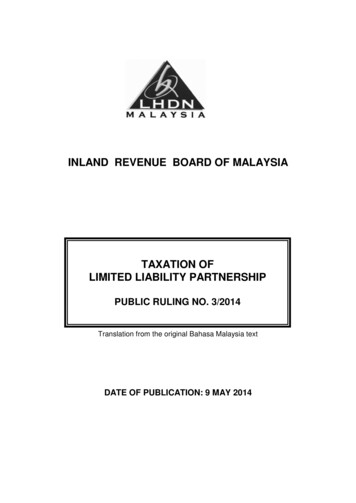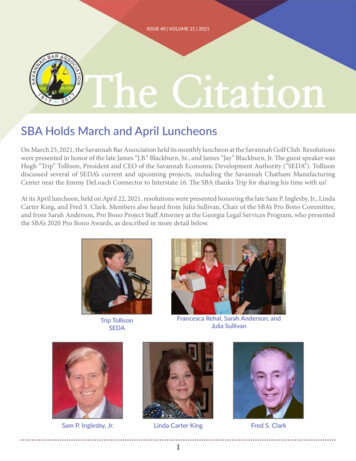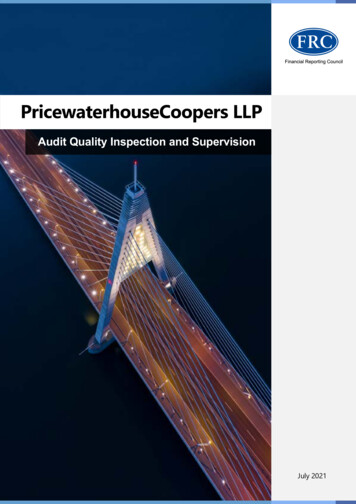
Transcription
PricewaterhouseCoopers LLPAudit Quality Inspection and SupervisionJuly 2021
The FRC does not accept any liability to any party for any loss, damage or costs however arising,whether directly or indirectly, whether in contract, tort or otherwise from action or decision taken(or not taken) as a result of any person relying on or otherwise using this document or arisingfrom any omission from it. The Financial Reporting Council Limited 2021The Financial Reporting Council Limited is a company limited by guarantee.Registered in England number 2486368.Registered Office: 8th Floor, 125 London Wall, London EC2Y 5ASFRC PricewaterhouseCoopers LLP Audit Quality Inspection and Supervision (July 2021)2
Contents1.Overview3.Review of firm-wide procedures2.Review of individual audits41419Appendices1.2.Firm’s internal quality monitoringFRC audit quality objective and approach to audit supervision3134This report sets out the FRC’s findings on key matters relevant to audit quality at PricewaterhouseCoopers LLP (PwC or thefirm). It is based on inspection and supervision work undertaken in our 2020/21 cycle, primarily our review of a sample ofindividual audits and our assessment of elements of the firm’s systems of quality control.The FRC‘s focus is on the audit of public interest entities (PIEs1). Our selection of individual audits and the areas withinthose audits for inspection continues to be risk-based focusing, for example, on entities which: are in a high-risk sector;are experiencing financial difficulties; have material account balances with high estimation uncertainty; or, where theauditor has identified governance or internal control weaknesses. The majority of individual audits that we inspect are ofPIEs but we also inspect a small number of non-PIE audits on a risk-based basis.Higher-risk audits are inherently more challenging as they will require audit teams to assess and conclude on complex andoften judgemental issues, for example in relation to future cash flows underpinning assessments of impairment and goingconcern. Rigorous challenge of management and the application of professional scepticism are especially important insuch audits.Our increasing focus on higher risk audits means that our inspection findings may not be representative of audit qualityacross a firm’s entire portfolio of audits or on a year-by-year basis. Our inspection findings cannot therefore be taken asa balanced scorecard of the overall quality of the firm’s audit work. However, our forward looking supervision work nowprovides us with a holistic picture of the firm’s approach to audit quality and the future development of its audit qualityimprovement initiatives.As well as risk-based selections, we aim to review all FTSE 350 audits periodically.To provide a more holistic assessment of audit quality, the report also includes reference to other measures of qualityat the firm. The Quality Assurance Department (QAD) of the Institute of Chartered Accountants in England and Wales(ICAEW) inspects a sample of the firm’s non-PIE audits, the results of which are summarised on page 8.The firm also conducts internal quality reviews. A summary of the firm’s internal quality review results is included atAppendix 1, together with the actions that the firm is taking in response.At Appendix 2 are further details of our objectives and approach to audit supervision.1 Public interest entity – in the UK, PIEs are defined in the Companies Act 2006 (Section 494A) as: - Entities with a full listing (debt or equity) on the London Stock Exchange(Formally “An issuer whose transferable securities are admitted to trading on a regulated market”. In the UK, “issuer” and “regulated market” have the same meaning as inPart 6 of the Financial Services and Markets Act 2000); - Credit institutions (UK banks and building societies, and any other UK credit institutions authorised by the Bank ofEngland); - Insurance undertakings authorised by the Bank of England and required to comply with the Solvency II Directive.FRC PricewaterhouseCoopers LLP Audit Quality Inspection and Supervision (July 2021)3
1 OverviewCommentary on our inspection work at the largest audit firmsWe completed more audit inspections at the largest seven firms in 2020/21 (103) than in2019/20 (88). Our overall inspection findings are similar to last year, with 71% of audits(73 out of 103 inspections) requiring no more than limited improvements compared to67% last year (59 out of 88 inspections).The number of audits that we have assessed as requiring improvements remains unacceptablyhigh. This year the results varied more between firms and we found inconsistencies, with goodpractice in some audits but deficiencies in the same areas in other audits at the same firm.The most common key findings in our public reports are in relation to revenue, impairment ofassets and group audit oversight. These are recurring issues but we also identified good practicein these areas in some audits.We also identified good practice during our 2020/21 thematic review of the audit of goingconcern, where we found that firms had responded positively to the increased risk arising fromCovid-19, by enhancing their procedures in this area2.Four of the largest firms (Deloitte, EY, Grant Thornton and PwC) had a year-on-year improvementin their overall inspection results, with around 80% or more of audits requiring no more thanlimited improvements. While this is encouraging, these improved results still fall short of ourexpectations.Overall inspection results at KPMG did not improve and it is unacceptable that, for the thirdyear running, we found that improvements were required to KPMG’s audits of banks and similarentities. In addition, our firm-wide work on KPMG’s IFRS 9 procedures and guidance identifiedthat further improvements are required to provide a stronger basis for KPMG’s banking auditteams to deliver high quality audits in this area. KPMG has already invested significantly in itsbanking audit practice and considers that, based on steps it has already taken, it will be able todemonstrate improvements in 2020 year-end audits. In response to our findings this year, thefirm’s senior leadership has committed to make the further changes necessary to improve auditquality in time for 2021 year-end audits. We will monitor these closely to assess on a timely basisthe extent to which they address our findings.This year, we increased the sample of audits we selected for review at BDO and Mazars, giventheir growth, with a focus on complex audits. Five of the nine audits that we reviewed at BDO andthree of the seven audits that we reviewed at Mazars needed more than limited improvements.These firms have grown the size of their PIE audit practices and have plans to grow further, whichwill increase competition and choice in the market. Our engagement indicates that these firmsare genuinely committed to improving audit quality but they must put in place the necessarybuilding blocks for the consistent execution of high quality audits as they grow.71%Overall, thenumber ofinspectionsrequiringno morethan limitedimprovementsfell short of ourexpectations.This year, resultsvaried morebetween firmsand we foundinconsistencies,with goodpractice insome audits butdeficiencies inthe same areasin other auditsat the same firm.2 etter.pdf; w-letter-(phase-2).pdfFRC PricewaterhouseCoopers LLP Audit Quality Inspection and Supervision (July 2021)4
Central to achieving consistent audit quality is a healthy culture within the audit practice thatencourages challenge and professional scepticism, as we set out in our letter to Heads of Auditin December 2020. We have a major project underway to examine audit culture, including aninternational conference held in June this year on the subject. Operational separation of auditpractices from the rest of the firm should help the largest firms to focus on developing anappropriate audit culture.Our supervision teams3 are increasing the range of pro-active and forward-looking work they arecarrying out with the largest seven firms in areas such as audit quality plans, root cause analysis,quality control procedures and audit quality indicators with a focus on how firms are respondingto recurring findings. We report privately to firms on our findings in these areas, in order to sharegood practice. In 2021/22 we will continue to focus our inspections on KPMG banking audits andwe will increase audit inspections at BDO and Mazars. Our 2021/22 inspections will also focus onand take into account the impact of Covid-19 on audits.Our supervisionteams areincreasingthe range ofpro-active andforward-lookingwork.All 32020/212172019/20Good or limited improvements requiredImprovements requiredSignificant improvements required82842672018/191642017/1882016/17FTSE 1222019/20Good or limited improvements requiredImprovements requiredSignificant improvements required564948321552018/1932017/1810In 2021/22 wewill continueto focus ourinspections onKPMG bankingaudits and wewill increaseaudit inspectionsat BDO andMazars.32016/173 Our approach to supervision is set out in the March 2021 publication, vision-FINAL.pdfFRC PricewaterhouseCoopers LLP Audit Quality Inspection and Supervision (July 2021)5
PwC overall assessmentWe reviewed 20 individual audits this year and assessed 16 (80%) as requiring no morethan limited improvements. Of the ten FTSE 350 audits we reviewed this year, we assessednine (90%) as achieving this standard.The firm has taken steps to address the key findings in our 2019/20 public report, with actionsthat included increasing resources, focused training and updates to audit guidance and workprogrammes. We have identified improvements, for example, in the group oversight of componentaudits and the audit of long-term contracts, both key findings last year. We also identified goodpractice in a number of areas of the audits we reviewed (including enhancing procedures to respondto heightened audit risks due to Covid-19 and the continued use of internal specialists and experts)and in the firm-wide procedures (including a number related to methodology and training).The main recurring findings related to the evaluation of management’s impairment and goingconcern assessments.PwC introduced a Programme to Enhance Audit Quality (PEAQ or the plan) in Summer 2019. Theplan is being phased over a three-year period and contains four workstreams. It also includesthe development of a framework for assessing the benefits of key actions and its progress andachievements are overseen by the newly established independent Audit Oversight Body. Culture,including encouraging healthy challenge, is central to the success of PEAQ and the firm is welladvanced in embedding “the critical few” behaviours into key areas such as career progression,reward and recognition and performance management. The framework for assessing the benefits ofkey actions is good practice. PEAQ formally ends in 2022 and the firm should develop an ongoingaudit quality plan to ensure that continuous improvement of audit quality remains a top prioritywithin the audit strategy that has sufficient prominence to be effective.80%At PwC, moreof the auditsreviewed inthe currentinspection cyclewere assessedas either goodor limitedimprovementsrequired.The firm has undertaken root cause analysis (RCA) for a number of years and follows methodologyand guidance set out by the global network, supplemented by UK specific procedures. The processeshave been improved, including in response to findings that we raised last year. The enhancementsinclude establishing a dedicated team to undertake RCA on a continual basis throughout the year,across internal and external reviews, and using trends and emerging issues from multiple sourcesacross the firm. This and some of the initiatives being established by this team are good practice.Importantly, the firm has begun to monitor the effectiveness of actions taken as a result of the RCAprocess, and will use the same “benefits realisation framework” used for measuring the success ofinitiatives taken under PEAQ. While the firm’s RCA includes techniques to respond to recurringfindings, further analysis still needs to be undertaken for the audit of impairment and going concern.We will continue to review the progress of PEAQ and the firm’s assessment of the benefits arising.FRC PricewaterhouseCoopers LLP Audit Quality Inspection and Supervision (July 2021)6
Our assessment of the quality of audits reviewed: PricewaterhouseCoopers 2019/202020/214Good or limited improvements requiredImprovements requiredSignificant improvements required522018/19202017/1802016/17FTSE 20/212019/20Good or limited improvements requiredImprovements requiredSignificant improvements required422018/19302017/18202016/17The audits inspected in the 2020/21 cycle included above had year ends ranging from 30 June2019 to 31 January 2020.Changes to the proportion of audits falling within each category reflect a wide range of factors,including the size, complexity and risk of the audits selected for review and the scope ofindividual reviews. Our inspections are also informed by the priority sectors and areas of focusas set out in Appendix 2. For these reasons, and given the sample sizes involved, changes fromone year to the next cannot, on their own, be relied upon to provide a complete picture of afirm’s performance and are not necessarily indicative of any overall change in audit quality atthe firm.Any inspection cycle with audits requiring more than limited improvements is a cause forconcern and indicates the need for a firm to take action to achieve the necessary improvements.FRC PricewaterhouseCoopers LLP Audit Quality Inspection and Supervision (July 2021)7
Monitoring review by the Quality Assurance Department of ICAEWThe firm is subject to independent monitoring by ICAEW, which undertakes its reviews underdelegation from the FRC as the Competent Authority. ICAEW reviews audits outside the FRC’spopulation of retained audits, and accordingly its work covers private companies, smaller AIMlisted companies, charities and pension schemes. ICAEW does not undertake work on thefirm-wide controls as it places reliance on the work performed by the FRC.ICAEW reviews are designed to form an overall view of the quality of the audit. ICAEWassesses these audits as ‘satisfactory’, ‘generally acceptable’, ‘improvement required’ or‘significant improvement required’. Audits are selected to cover a broad cross-section ofentities audited by the firm and the selection is weighted towards higher-risk and potentiallycomplex audits within the scope of ICAEW review.ICAEW has completed its 2020 monitoring review and the report summarising the audit filereview findings and any follow up action proposed by the firm will be considered by ICAEW’sAudit Registration Committee in September 2021.SummaryOverall, the audit work we reviewed was of a good standard, with nine of the ten reviews eithersatisfactory or generally acceptable. One audit required improvement. These results are betterthan the prior year reviews, when seven of the ten audits were either satisfactory or generallyacceptable, two required improvement and one required significant improvement.For the audit requiring improvement, there was insufficient challenge of management in relationto the revenue recognition policy originally adopted in prior years, and a lack of evidence onthe audit file of the audit team’s continued consideration of the basis on which managementrecognise revenue.90%Of the tenICAEW reviews,nine were eithersatisfactoryor generallyacceptable.On the audits assessed as generally acceptable, there were isolated gaps in the documentationof key audit work and judgements, including work on contract accounting, inventory provision,accounting treatment of an intercompany loan write off, and revenue recognition.ICAEW identified and shared examples of good practice on some of the reviews.ResultsResults of ICAEW’s reviews for the last three years are set out below.100%80%60%112928740%20%0%2020Satisfactory /generally provement requiredGiven the sample size, changes from one year to the next in the proportion of audits fallingwithin each category cannot be relied upon to provide a complete picture of a firm’sperformance or overall change in audit quality.FRC PricewaterhouseCoopers LLP Audit Quality Inspection and Supervision (July 2021)8
Review of individual auditsOur key findings related primarily to the need to: Improve the evaluation of aspects of management’s impairment and going concernassessments. Enhance the testing for the valuation of certain pension assets. Improve the audit procedures for the residual journal population in response to the risk ofmanagement override.Good practice observationsWe identified examples of good practice in the audits we reviewed, including the following: Effective group oversight.Robust assessment of management’s going concern assumption.Effective use of the firm’s internal experts and specialists.Effective procedures over revenue and long term contracts.Quality of the firm’s summaries of audit responses to significant risks and related findings.Review of firm-wide proceduresThis year, our firm-wide work focused primarily on the following areas: Audit quality initiatives. RCA process. Audit methodology and training.The reason for the focus on RCA and audit quality initiatives is the importance of taking effectiveaction to address recurring inspection findings. On both of these areas we have assessed the firm’sprogress on the findings set out in last year’s public report and re-assessed overall progress.Audit quality initiativesOur key findings in this area were related to the need to: Develop an Audit Quality Plan for the future to operationalise the audit strategy, ensure auditquality remains a top priority beyond PEAQ and capture key audit quality initiatives to beregularly reports on to the firm’s Audit Oversight Board.RCA processOur key findings in this area were related to the need to: Undertake further analysis through RCA and an action effectiveness assessment given certainrecurring findings included in this report.Audit methodology and trainingWe had no key findings to report.FRC PricewaterhouseCoopers LLP Audit Quality Inspection and Supervision (July 2021)9
Good practice observationsWe identified examples of good practice in our review of firm-wide areas, including thefollowing: Audit quality initiatives – The introduction of a benefits realisation framework to assessboth progress and impact; and The governance of PEAQ remains strong, with regular reportsand updates on both progress and benefits realised. RCA process – Use of a dedicated RCA team; The introduction of a taxonomy of risk factors;Continual RCA activities; Embedding culture in RCA activities and materials; and Analysis ofAQIs and correlations with lower rated reviews. Audit methodology and training – Clear consequences for not completing mandatorytraining; Identification of residual knowledge gaps following training; Monitoring the numberof attempts an individual takes to pass a post course assessment; The frequency and qualityof ongoing communications to partners and staff; The guidance to audit teams on commoncontrols at banking entities; and Use of an economics tool on certain banking audits tocompare management forecasts to independent forecasts.Firm’s overall response and actionsWe are encouraged by the improved inspection results for audits selected by the FRC aspart of the 2020/21 inspection cycle, and in the audits selected by the Quality AssuranceDepartment (QAD) of the ICAEW for their 2020 inspection. Whilst we continue to focus onachieving consistent high quality, particularly in respect of the evaluation of management’simpairment and going concern assessments which was the main finding in this year’s FRCinspection, we are pleased that other previous recurring findings, in respect of long termcontract auditing, and the audit of groups, were not identified. We also welcome the broaderrange of good practice examples identified by the FRC and QAD during their inspections. Weremain focused on identifying and addressing risk factors which have contributed to the lowerrated inspections and, more broadly, on continuous improvement to achieve consistently highquality audits.We welcome the number of examples of good practice that were identified during thefirmwide review cycles, including on PEAQ, RCA, methodology and training and within thefeedback received on the 2020/21 thematic review cycles, including going concern. Wecontinue to focus on supporting our engagement teams and appreciate the observations inrespect of our audit quality plan and root cause analysis. Our designated methodology andtraining teams are focused on providing high quality updates, training and guidance to ouraudit practice. Investment in training has also been a key feature of PEAQ. The identificationof good practice by the FRC assists these teams in replicating their approach across allactivities.We also welcome the enhanced approach to supervision following the FRC’s restructure of itssupervisory organisation in October 2020. The co-ordination of activities between the AuditFirm Supervision team, the Audit Quality Review team and the Audit Market Supervision teamhas already been seen to help bring together activities and facilitate more regular interactions.We look forward to the continued sharing of good practice insight, raising of concernsand issues, and timely discussions of emerging topics for auditors which this structure willfacilitate. We also consider the proactive approach to more timely thematic briefings to havebeen beneficial for all audit stakeholders.FRC PricewaterhouseCoopers LLP Audit Quality Inspection and Supervision (July 2021)10
Programme to Enhance Audit Quality (PEAQ)The PEAQ was launched in June 2019 as a three year programme covering the period toJune 2022. It includes a wide-ranging and fundamental package of measures, with thesingle objective of delivering consistently high quality audits. The PEAQ underpins our auditstrategy, which is centred around a commitment to high quality, embedding this approachinto all our activities.The PEAQ identified four change workstreams - Structure and Governance, Culture andRecognition, Supply and Demand, and Quality Control Activities. During the first two yearsof the PEAQ, a number of the original workstreams set out have evolved to incorporate newactions as the programme has progressed, and additional challenges have been identifiedthrough RCA activities. As part of our Culture and Recognition workstream, the critical auditbehaviours, ‘challenge and be open to challenge’, ‘team first’ and ‘take pride’ were launchedin September 2019.In late 2020 we developed a benefits realisation framework to assess whether the actionswithin the PEAQ were effective and whether the changes required to underpin audit qualitywere embedding. Whilst a number of inspected audits were performed shortly after theprogramme launch we believe there are many positive indicators that the PEAQ is embeddingthe desired change. When the PEAQ is completed, our aim is for the primary focus on auditquality to be fully embedded, both in our audit strategy and the activities and behaviours ofour audit practice.Our Audit strategy for FY23 and beyond will incorporate the plan for audit quality, includingthe regular reporting of any audit quality initiatives to the Audit Oversight Body (AOB). Thiswill be developed during FY22.Continuous ImprovementThe Continuous Improvement Team (CIT) was established in July 2020 to deliver RCA activitieson a dedicated and consistent basis. Our CIT aims to proactively support our audit practiceby analysing data and insight obtained from internal and external review activities, and byevaluating action timing and action effectiveness, to determine rapid and effective responsesto emerging quality matters. The CIT also aims to identify and share best practices to provideour engagement teams with insight into positive audit behaviours and promote consistentlyhigh quality audits.For the 2020/21 inspection cycle, the CIT has undertaken detailed RCA using our globalnetwork RCA guidance, supplemented by the standardised UK RCA approach which wasapproved by the Audit Executive in February 2020. The current year RCA on FRC inspectionfindings began with a comparative analysis of the key findings from the inspection activities,for 2020/21 as compared with 2019/20, to understand how the specific matters arising hadevolved. This analysis also enabled the CIT team to evaluate in-progress action effectiveness,and an identification of additional actions required for any systemic matters.The UK RCA methodology uses a risk factor taxonomy to consistently assess and score causalfactors from data analysis, interviews and focus groups. These causal factors are referredto as ‘risk factors’ to reflect the fact that usually the root cause of matters arising on auditinspections relate to a combination of risk factors, rather than one factor. This methodologyenables the CIT to identify whether there are any risk factors that are pervasive acrossengagements, those that are concentrated in the reported key findings, or factors that featuresignificantly in lower rated inspections. Factors identified as specific to lower rated inspectionsare assessed separately to ensure there are no further actions required over and above thosealready proposed in response to any pervasive factors or those relating to key findings, eitherfor PwC Audit or at an engagement team level.FRC PricewaterhouseCoopers LLP Audit Quality Inspection and Supervision (July 2021)11
The establishment of the CIT also helps ensure a focus on best practice, that actions aredesigned effectively, with our engagement teams directing their efforts appropriately.For all inspected audits, actions to address the specific findings were also agreed by theengagement team with the FRC.Risk Factors and actionsIn previous years, our RCA has identified a number of risk factors as being pervasive acrossthe engagements subject to inspection by the FRC. This year, whilst the FRC report includeskey findings in recurring topic areas, the RCA found the specific nature of the detailedfindings to have narrowed within these topic areas since the 2019/20 inspection cycle and therisk factors arising were not seen consistently across the engagements. As such, no pervasiverisk factors were identified this year, rather the risk factors arising were either specific to theengagement or to the key finding, or topic area identified.Our RCA highlighted that the PEAQ cultural change programme has had a positiveimpact on high performing engagement teams. Through discussion with these teams, itwas clear that the critical few behaviours resonated, and they provided clear examplesof how the behaviours had been embedded in their engagements. There was a focus onstrong teamwork (‘Team First’), engagement team members challenging themselves andmanagement to deliver a high quality audit (‘Challenge and be open to Challenge’), allunderpinned by pride in the work performed (‘Take Pride’). We will continue to focus onembedding the cultural change programme.The most significant risk factors identified by the CIT for the 2021/22 inspection cycle were: Insufficient scepticism or challenge due to an over-reliance on broader client knowledge orthe prior year audit approach. Whilst this factor was present in the previous year, this year wealso identified a number of good examples of robust challenge of management, includingin lower rated inspections. We will continue to focus on embedding the cultural changeelements of the PEAQ, and in particular the Challenge and be open to Challenge behaviour,to further improve auditor consistency in this area; and Poor quality audit deliverables and the need for improved project management, particularlyat the conclusion of the audit process. During FY21, we piloted our “Breaking the AuditCycle” (BtaC) initiative which introduced audit planning milestones. For FY22, BtaC willbe implemented by all audit teams, and will be expanded to include milestones for theexecution phase of the audit. This will help to facilitate the development of an effectiveproject timetable, including the agreement of quality audit deliverable responsibilities withmanagement.These risk factors were primarily identified in relation to the main key theme identified by theFRC, the evaluation of aspects of management’s impairment and going concern assessments.They did not predominantly feature in the key findings raised on testing of pension assetvaluation or residual population testing for journals where changes in and application ofmethodology and guidance were the more predominant risk factors. Additional risk factorsspecific to the lower rated engagements included isolated resourcing or team compositionchallenges and an expectation gap relating to the extent of evidence required to support anauditor conclusion.On a continual basis, the CIT undertakes a holistic approach to action planning across allRCA activities. Action planning either enhances actions already in progress, for examplewithin the PEAQ programme, or identifies new actions where necessary. All additionalactions are consolidated into a sin
year running, we found that improvements were required to KPMG's audits of banks and similar entities. In addition, our firm-wide work on KPMG's IFRS 9 procedures and guidance identified that further improvements are required to provide a stronger basis for KPMG's banking audit teams to deliver high quality audits in this area.
